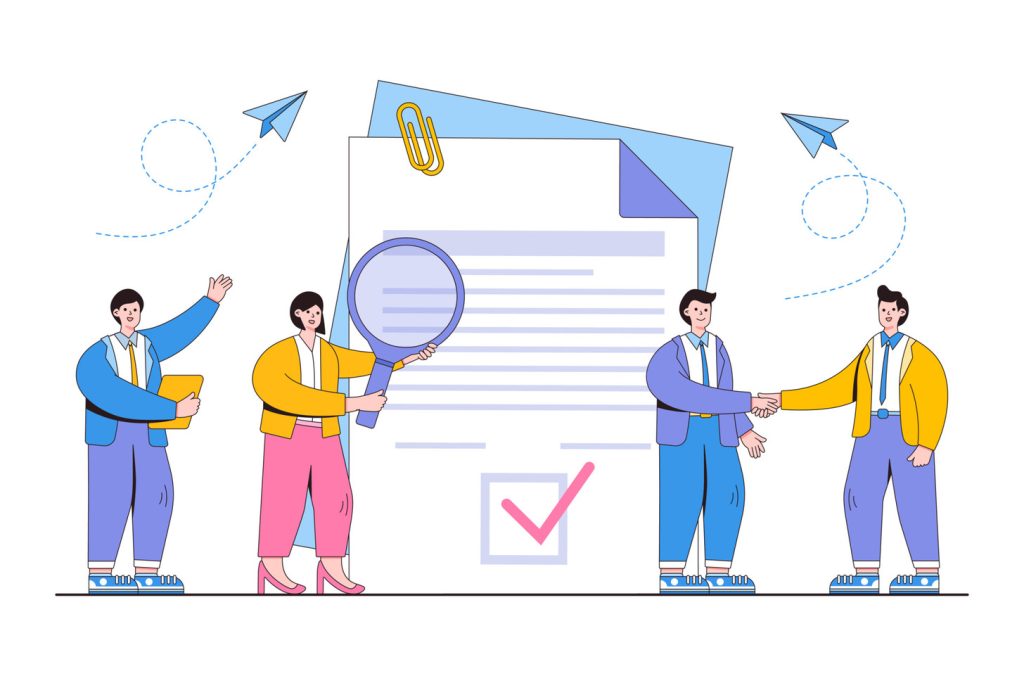Mastering Approval Processes: A Step-by-Step Guide

Every successful business relies on structured systems to handle daily decisions. Without clear frameworks, companies risk delays, errors, and missed opportunities. This guide reveals how to transform chaotic workflows into strategic assets that boost efficiency and compliance.
Modern organizations face unprecedented demands for rapid decision-making. Documents, projects, and transactions require swift yet thorough reviews. Effective workflow design eliminates bottlenecks while maintaining accountability – a balance critical for scaling operations.
Leaders who implement optimized systems see measurable improvements. Teams complete tasks faster, stakeholders trust outcomes, and audits become straightforward. These advantages directly impact competitiveness in fast-moving markets.
This resource provides actionable methods to align workflows with specific business goals. From initial design to continuous improvement, each strategy focuses on practical execution. Decision-makers gain tools to replace outdated methods with modern solutions that drive growth.
Key Takeaways
- Structured workflows convert random decisions into repeatable success patterns
- High-volume operations demand systematic review mechanisms
- Optimized systems reduce delays by 40-60% in most organizations
- Clear accountability improves compliance with industry regulations
- Step-by-step redesigns address common productivity barriers
Introduction: Understanding Approval Processes and Workflow Efficiency
In today’s fast-paced corporate environment, structured decision-making frameworks separate thriving companies from stagnant ones. These systems embed oversight directly into daily operations, turning routine reviews into strategic advantages. Workflow efficiency isn’t just about speed—it’s about creating repeatable patterns that align teams and reduce friction.
Defining Systematic Frameworks
Structured review mechanisms act as guardrails for business activities. They replace ad-hoc decisions with standardized criteria, ensuring consistency across departments. A well-designed framework answers three questions: Who approves what? When does input matter most? How do teams track progress?
Consider how multinational corporations handle vendor contracts. Predefined evaluation steps prevent bottlenecks while maintaining compliance. This approach transforms chaotic reviews into predictable outcomes.
Workflows as Growth Catalysts
Efficient systems directly impact organizational agility. Teams spend 35% less time chasing approvals when roles and timelines are clear.
“The best workflows don’t just move faster—they create visibility that builds stakeholder trust,”
notes a Fortune 500 operations director.
Key benefits emerge when systems prioritize transparency:
- Reduced cycle times for critical decisions
- Automated escalation paths for overdue tasks
- Real-time audit trails for compliance reporting
Companies using optimized methods report 52% fewer errors in financial approvals. These results prove that smart workflow design isn’t optional—it’s essential for scaling modern enterprises.
Benefits of Effective Approval Processes

Systematic frameworks for business reviews deliver measurable improvements across operations. When designed strategically, these systems accelerate outcomes while fortifying organizational safeguards. Two critical advantages emerge: operational velocity and financial protection.
Increased Efficiency and Speed
Businesses implementing structured review methods cut approval cycle durations by up to 50%. Teams redirect hours previously lost to manual follow-ups toward revenue-generating tasks. One logistics firm reduced contract processing from 14 days to 72 hours after redesigning their system.
Key impacts include:
- Faster product launches through synchronized stakeholder input
- Real-time status tracking eliminating redundant check-ins
- Automated escalations resolving 89% of overdue tasks
Enhanced Compliance and Cost Reduction
Robust frameworks prevent costly oversights. Financial institutions using automated audit trails report 63% fewer regulatory penalties. Clear documentation standards simplify compliance reporting while deterring fraudulent activity.
“Visibility into decision chains reduces risk exposure more effectively than manual checks,”
observes a banking compliance officer.
Secondary benefits compound over time:
- 15-30% lower administrative costs through eliminated redundancies
- Error rates dropping below 2% in high-volume transactions
- Resource reallocation to strategic initiatives boosting profitability
Designing a Robust Approval Process
Well-structured decision frameworks turn routine reviews into competitive advantages. Organizations that prioritize systematic design principles experience fewer delays and stronger compliance outcomes. Strategic alignment between review requirements and operational goals separates functional systems from bureaucratic roadblocks.
Establishing Clear Criteria and Stakeholder Roles
Defining authorization thresholds prevents unnecessary bottlenecks. Monetary limits and risk tiers determine when reviews become mandatory. A manufacturing company might require executive sign-off for purchases exceeding $250,000 but delegate smaller transactions to department heads.
Role mapping matches decision authority with expertise levels. Legal teams review contract clauses while finance leads assess budgetary impacts. This specialization reduces errors by 41% in cross-functional operations.
Mapping Out Process Steps
Visual workflow diagrams expose inefficiencies before implementation. Teams spot redundant handoffs or unclear escalation paths during planning stages. One healthcare provider eliminated 12-hour delays by shortening approval chains through this method.
Documented procedures maintain consistency during staff transitions. New hires reference step-by-step guides to navigate complex authorization requirements. Regular audits ensure frameworks adapt to evolving business priorities without sacrificing oversight quality.
Step-by-Step Guide to Creating Approval Workflows

Building efficient decision pathways requires precise planning and strategic automation. This roadmap helps teams transform chaotic reviews into structured systems that accelerate outcomes while maintaining oversight.
Identifying Triggers and Approver Types
Workflow triggers act as launch points for review sequences. Common initiators include purchase requests exceeding budget thresholds or project milestone submissions. Teams must document these activation points to prevent unauthorized bypasses.
Approver selection balances expertise with availability. Legal teams might handle contract clauses, while department heads authorize operational expenses. Clear role definitions reduce bottlenecks by 37% in cross-functional environments.
- Sequential reviews maintain hierarchical oversight for high-risk decisions
- Parallel authorization accelerates routine requests needing multiple inputs
- Backup approvers prevent workflow stalls during absences
Automating Actions to Reduce Delays
Digital tools eliminate manual handoffs through preset rules. Email notifications alert stakeholders when input is required, while dashboards track progress in real time. One tech firm cut processing times by 58% after implementing automated escalation paths.
“Systems that auto-route tasks based on preset conditions maintain momentum better than manual assignments,”
notes a software development director.
Critical automation features include:
- Conditional routing based on request type or risk level
- Deadline-driven reminders with escalation protocols
- Integration with document management platforms
Regular performance reviews identify optimization opportunities. Metrics like average resolution time and approver workload help refine workflow efficiency over time.
Leveraging Approval Processes for Workflow Automation
Modern businesses achieve decision velocity through intelligent authorization designs. Strategic workflow automation transforms manual reviews into precision-guided systems that align with operational rhythms. This approach balances speed with oversight, creating self-correcting mechanisms that adapt to shifting priorities.
Choosing Between Sequential and Parallel Approvals
Two primary models dominate efficient review systems. Sequential workflows follow a fixed order, ideal for high-stakes decisions requiring layered expertise. Parallel methods enable simultaneous evaluations, cutting processing time for routine tasks.
| Model | Use Cases | Average Resolution Time | Error Rate Reduction | |
|---|---|---|---|---|
| Sequential | Contract negotiations | Regulatory compliance | 48-72 hours | 34% |
| Parallel | Travel requests | Software deployments | 6-12 hours | 18% |
Financial institutions using sequential chains report 29% faster audit closures. Tech startups adopting parallel methods reduce product launch delays by 41%. The choice hinges on risk tolerance and urgency.
Automation tools eliminate manual routing errors. Cloud-based systems send reminders when tasks stall, while dashboards show real-time progress. One logistics company reduced invoice approvals from 14 days to 38 hours through conditional routing logic.
Key implementation steps:
- Map decision hierarchies to risk categories
- Set escalation rules for overdue tasks
- Integrate with existing CRM or ERP platforms
Users gain clarity through intuitive interfaces that guide next steps. Approval histories become searchable, turning past decisions into training resources. These features create self-sustaining systems that improve as teams adapt. Additionally, teams can analyze approval patterns to identify effective approval strategies for projects, streamlining their workflow further. By leveraging this data, organizations can foster a culture of continuous improvement, ensuring that best practices are consistently refined and shared. This not only enhances team collaboration but also accelerates project delivery, driving overall success.
Integrating Approval Processes with Business Operations

Operational excellence demands seamless alignment between decision frameworks and daily activities. Disconnected systems create friction, while integrated solutions amplify strategic outcomes. Centralized platforms bridge departmental gaps, turning fragmented tasks into unified workflows.
Strategic Goal Synchronization
Tech-driven authorization tools synchronize with company objectives through customizable rules. A retail chain reduced budget discrepancies by 44% after linking purchase requests to financial targets. These systems adapt to shifting priorities without manual reconfiguration.
Core integration advantages include:
- Unified dashboards showing real-time progress across teams
- Automatic policy updates reflecting regulatory changes
- Data pooling from CRM and ERP systems for context-rich reviews
“Systems mirroring our compliance needs cut audit prep time by 60%,”
states a healthcare IT manager. Embedded controls ensure decisions meet standards without extra oversight steps.
Performance metrics track system effectiveness against operational benchmarks. Teams identify bottlenecks through cycle-time analytics, enabling continuous refinement. Cross-departmental visibility fosters collaboration, as marketing and finance teams jointly optimize campaign budgets.
To ensure seamless transitions, change management protocols maintain stability during upgrades. Meanwhile, version-controlled workflows allow organizations to test improvements safely and effectively. Ultimately, this balance between innovation and reliability sustains user trust while driving significant efficiency gains.
Advanced Strategies and Best Practices

Forward-thinking organizations enhance operational precision through tailored authorization protocols. These methods balance flexibility with control, adapting to unique operational demands while maintaining oversight integrity.
Customizing Steps and Notifications
To enhance user input accuracy, dynamic request forms guide users to provide essential details upfront. For example, a marketing agency reduced revision rounds by 67% by using auto-populated fields linked directly to CRM data. Moreover, time-bound rules prevent delays — with 92% of tasks meeting deadlines when systems automatically flag aging requests. Incorporating these features not only streamlines the workflow but also improves client satisfaction, as users can see their requests processed more efficiently. Companies exploring the best CRM solutions for approvals can significantly benefit from similar dynamic forms and automated tracking systems. This approach not only accelerates the approval process but also enhances collaboration among teams, ensuring everyone is on the same page.
| Notification Feature | Standard Systems | Advanced Systems |
|---|---|---|
| Delivery Channels | Email only | Slack/MS Teams + SMS |
| Timing Options | Fixed intervals | Recipient timezone sync |
| Escalation Rules | Manual reassignment | AI-driven rerouting |
Managing Exceptions and Optimizing Workflow
Specifically designed for complex scenarios, controlled bypass protocols handle edge cases without compromising oversight. Notably, financial institutions using tiered exception logging report a 31% faster resolution of non-standard requests. In addition, real-time dashboards track deviation patterns to continuously refine and optimize core workflows.
“Monthly cycle-time analysis uncovered $280k in recurring procurement delays we’d normalized as ‘business as usual’,”
reveals a manufacturing operations lead.
Optimization tactics deliver measurable gains:
- Automated load balancing distributes review tasks evenly
- Role-specific training modules boost first-time approval accuracy
- Quarterly stress tests validate system resilience
Leveraging Salesforce Flow for Approval Workflows
In today’s fast-paced environment, modern automation tools now reshape how teams manage essential business operations. Among these solutions, Salesforce Flow emerges as a powerful tool for crafting tailored authorization systems that adapt to evolving business needs. Furthermore, its latest features eliminate traditional constraints through intuitive design and seamless native platform integration.
Understanding Flow Approval Orchestration
With the Spring ’25 release, Salesforce introduces Flow Approval Orchestration, enabling teams to build complete authorization systems within the platform. Specifically, this innovative framework uses stages and steps as core components, allowing sequential or parallel execution based on predefined conditions. As a result, organizations can now efficiently handle multi-department reviews through a single interface — all without the need for custom coding.
Benefits of New Flow Features in Spring and Summer ’25
To begin with, recent updates proactively address critical operational gaps across workflows. In particular, record-triggered orchestrations automatically launch when specific data changes occur, ensuring timely automation. Simultaneously, autolaunched versions seamlessly integrate with external systems, enhancing cross-platform connectivity. Notably, Summer ’25 enhancements introduce recall capabilities, allowing users to retract requests before finalization — a game-changing feature for fast-moving projects and agile teams.
Specifically in modern DevOps environments, fault path management transforms error handling by intelligently routing exceptions to designated teams. According to recent Salesforce benchmarks, this innovative feature significantly reduces resolution times by 47% in early adopters. Moreover, when integrated seamlessly with existing permissions and data structures, these advanced tools create resilient systems that efficiently scale with ongoing organizational growth.
Businesses gain competitive agility through customizable automation that aligns with unique operational rhythms. Salesforce’s no-cost licensing model makes advanced workflow design accessible to teams across industries, proving smart technology investments drive measurable efficiency gains.

